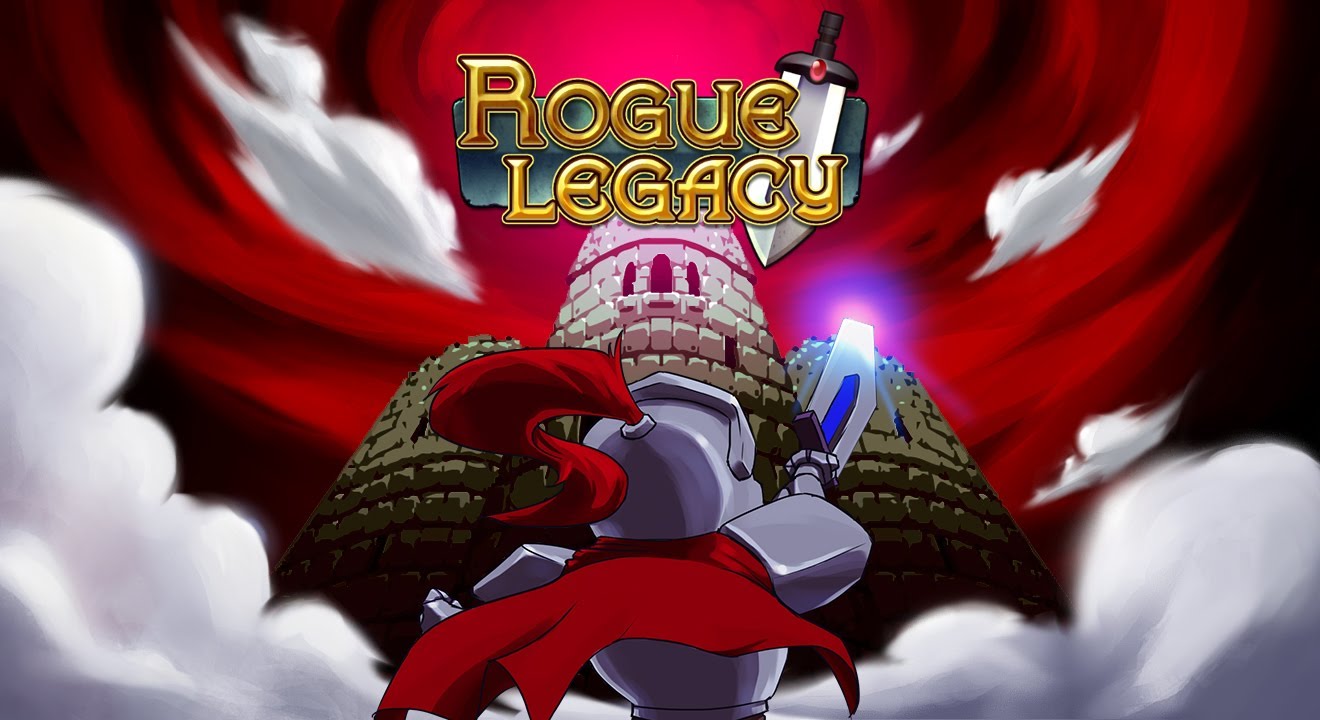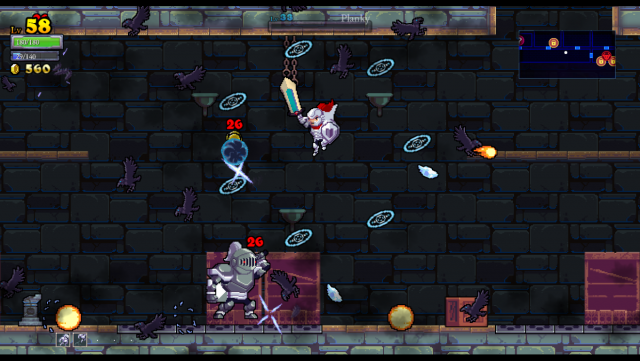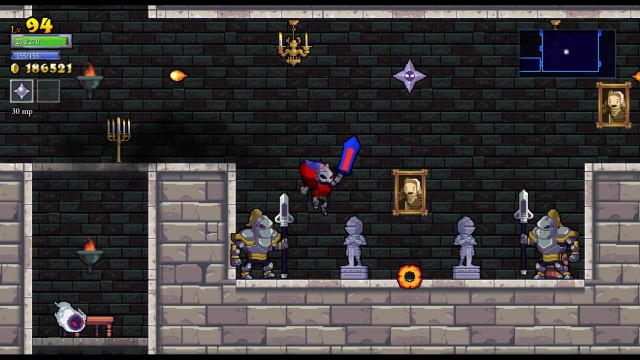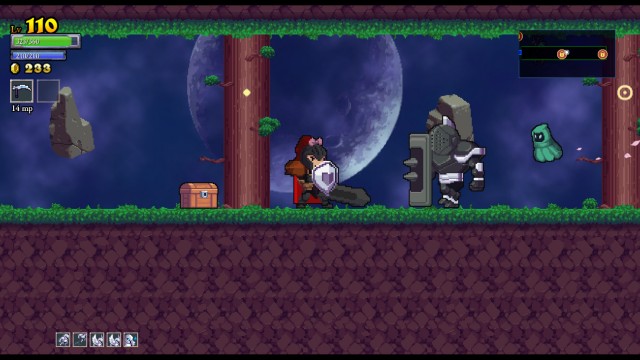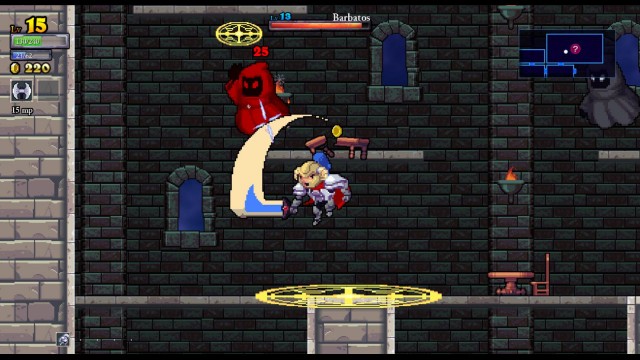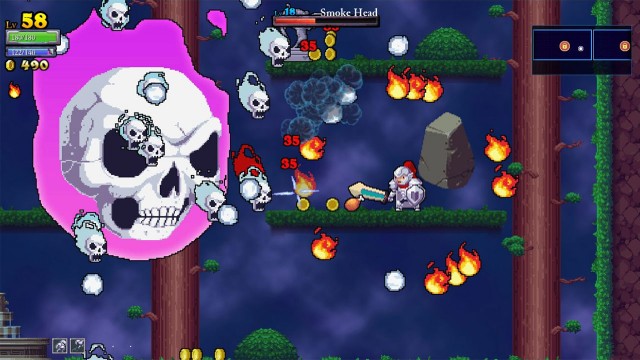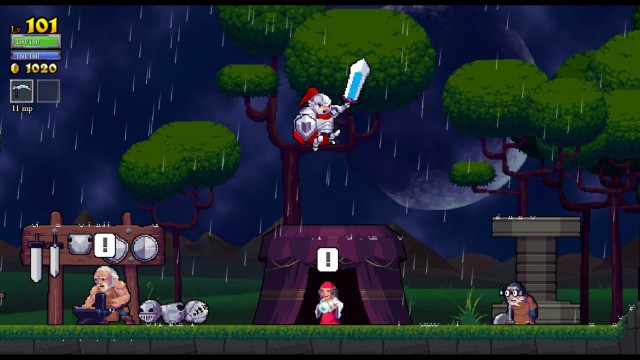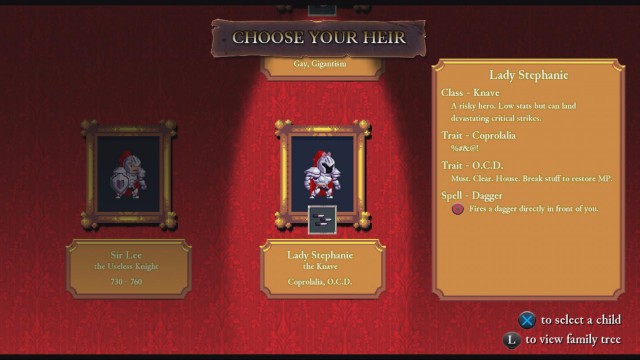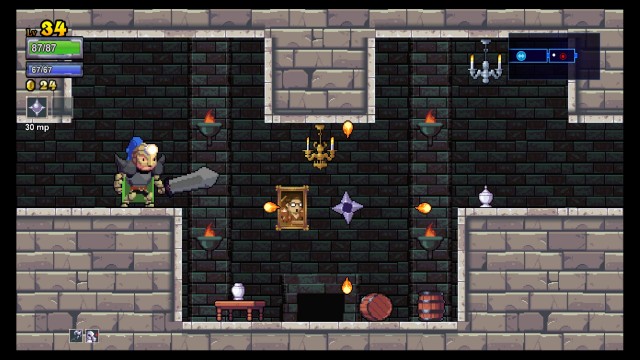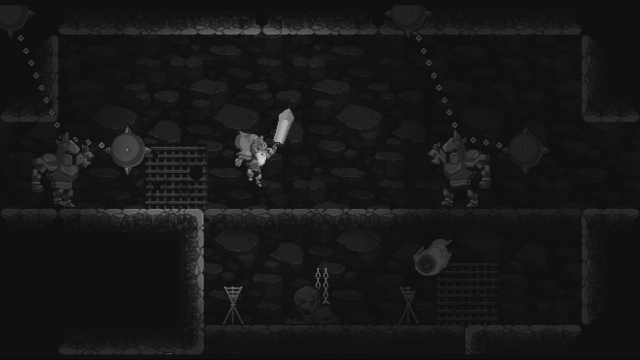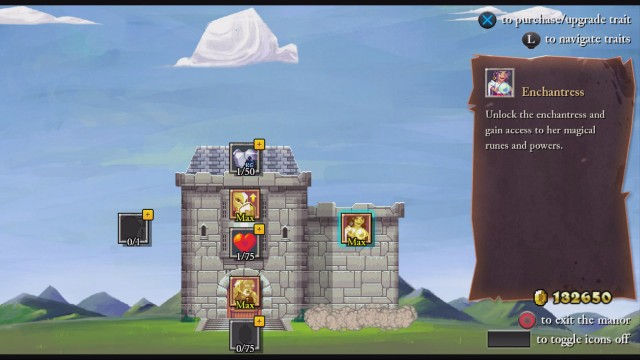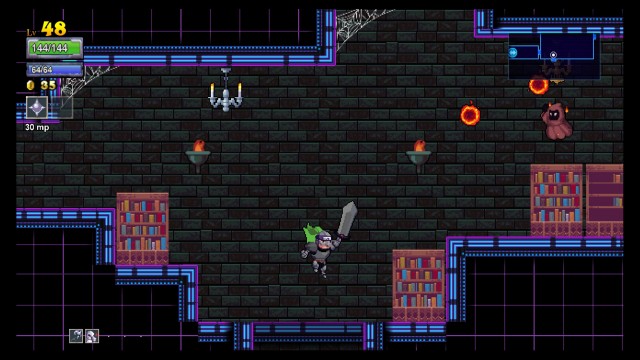UPDATE: While our review primarily focuses on the PlayStation re-releases of Rogue Legacy, along with commentary on the original PC, Mac and Linux builds, we have updated the review with an additional section to include impressions of the further belated Xbox One version of the game.
Rogue Legacy offers a quest that spans generations, quite literally! As you continually throw yourself at the devious challenges and ruthless enemies of a continually randomized dungeon layout, you’ll often die, only to be replaced by an all-new hero, a descendant of the hero that fell before them. With each new generation, comes a randomized array of specialties, and even some quirky physical traits that really challenge players to master an eccentric cavalcade of would-be warriors!
Originally released for PC last year, as the most ambitious effort yet for fledgling Toronto-based developer, Cellar Door Games, Rogue Legacy received loads of acclaim and scads of purchases, being one of the most celebrated indie hits of PC gaming in 2013. Now, the game has come to PlayStation platforms as the tip of the spear for Sony’s Summer PLAY 2014 line of PlayStation Store games, being cross-buy and simultaneously available across PS3, PS Vita and PS4 alike.
As with many cases of Sony bringing a hit PC indie game to one of their platforms, Rogue Legacy is better than ever on PlayStation platforms as well! All of the refinements and extra content that were added to the PC version since its initial release are all present and accounted for in the PlayStation builds, along with superb optimization across all three of Sony’s current devices, and a few all-new PlayStation-exclusive extras to boot, including some new dungeon arrangements, and even some brand new potential heroes to play as!
If you’ve already played through Rogue Legacy on PC, the PlayStation versions don’t really merit a double-dip. The game itself is still largely unchanged from its original PC build, even if the PS Vita port should prove especially attractive to people who like the idea of taking this game on the go. If you have yet to experience this fantastic indie gem however, and you happen to own any or all of Sony’s current platforms, Rogue Legacy demands to be experienced by anyone who is looking for a rewarding challenge and a compelling addiction!
All three PlayStation builds effortlessly run at 60fps, and they all look just as charming as the original PC build did. Given the simple pixel sprites and modest environmental design, the graphics aren’t especially ambitious in any version of Rogue Legacy, but at least everything is endearing and fun to look at.
The PC version has very undemanding system requirements, even on optimal settings, so as you can imagine, there’s no real difference in visual fidelity between the PlayStation ports, beyond the expected foibles. Predictably, the PS4 version runs at native 1080p resolution, with the PS3 version capping at 720p, though unless you’re running the two side-by-side, you’d be hard pressed to tell the difference between them. Even the PS Vita version stands pretty effortlessly with its console siblings from a visual standpoint. Naturally, the graphics are noticeably compressed to fit the Vita’s screen in that version, but beyond looking a bit shrunken down, they still present the same graphical quality as on PS3 and PS4.
With that said, the PS Vita version of Rogue Legacy does have slightly longer load times, especially when first starting the game, so bear that in mind. Even the PS3 version takes a little while to start up, though it loads pretty smoothly after that. The PS4 version however performs remarkably well, having the smallest load times, and almost no lag between starting up the game, moving between menus and whatever else. All three PlayStation builds of Rogue Legacy may boast good optimization, but the game’s optimization is at its best on PS4 for sure, with the PS Vita version feeling like an exact downscaled port of the console builds, with no Vita-specific functionality at all, and the PS3 version chugging at startup.
Beyond that however, the visuals are still all about simple functionality. The PlayStation versions are indistinguishable from the original PC build, which has a quaint, simple look. The straightforward environments don’t have much flair to them, and the 16-bit sprites feel plunked in from the early days of the Sega Genesis. Everything looks very cute thanks to its retro chic style, but don’t expect a lot of bells and whistles.
Like the graphics, the music is very simple and there isn’t much to say about it. The adorably noble title and character menu themes do a good job of helping you relax and feel inspired before you have another go at the uncompromising dungeon environment ahead, and in the dungeon itself, a slew of fun melodies keep you in the mood to slay monsters and seek treasure.
While the later dungeon areas are all about ominous ambiance for the most part, the initial castle area theme, a mix of harsh stomping and 16-bit synth, welcomes you to the fun nicely by combining a sense of pride with a sense of imminent danger. Appropriately, the music feels more suffocating in each tier of new area, almost reflecting the player’s change in state of mind as they lose more and more heroes trying to reach their ultimate goal. The same could be said about each successive boss theme as well, which gradually become more heavy and foreboding with each encounter.
Sound effects, as you can imagine, are cartoony and straightforward. Some of the menu effects present more realistic sounds of swords clanging and armour binding, but in the castle, most of the sound consists of the same vague buzzes and thwacks that you’d hear in just about any action game on the Super NES. Each monster is given several of their own effects for both being damaged and dealing damage to you, which is a nice touch, and helps to make every foe a little more personalized. The puff of smoke that sounds with each monster you slay also sounds incredibly satisfying every time you hear it, particularly given Rogue Legacy’s rather high difficulty.
There isn’t really any voice acting to speak of, though male and female heroes both have their own goofy little voice clips that play for various actions, often when they take damage or die. The unsettling cackle of Charon, the gatekeeper never gets any more comfortable to hear every time you lead a new hero into the dungeons though!
Again, not much to say about the audio, but it’s not without its charm.
Rogue Legacy is an open-ended 2D platformer with roguelike elements. In layman’s terms, it’s a simply presented action game that has you moving through a persistent castle-like arrangement of dungeons, not unlike the Castlevania games on the Game Boy Advance and DS. Players can jump with the X Button, swing their sword with the Square Button, cast spells with the Circle Button, and move with either the Directional Buttons or the Left Analog Stick, with the Triangle Button used for certain special functions.
On paper, it’s a very simple game. Players have to lead their hero through a randomized dungeon layout, fighting monsters and jumping around obstacles, trying to find their way to treasures, collectibles, and most of all, a special chamber that will allow them to take on each section’s boss. The dungeon is divided into four areas; Castle Hamson, Forest Abkhazia, The Maya, and the Land of Darkness, in ascending order of how strong and vicious their monsters are. Only by slaying the bosses of all four of these areas will you open the door to the game’s ultimate and final challenge.
Of course, what sounds simple in theory is anything but in practice! For starters, Rogue Legacy is not a cakewalk. Even with a smoothed-out difficulty curve in the PlayStation versions compared to the original PC release, monsters hit very hard, and their patterns take a lot of practice to adequately avoid, especially when several monsters attack you at once. The first time you lead a hapless hero through the game’s dungeons, it’s not unfeasible that you would only make it a few rooms before being unceremoniously killed.
Death is permanent in Rogue Legacy as well, at least, in a manner of speaking. Every time one of your heroes is slain in battle, you’ll restart with a brand new hero, though one that maintains some of the development of their predecessors. Each hero has a random set of traits and specialties, and you’re given a choice between three potential heroes to continue your family tree.
What successive heroes maintain is the perks you purchase in The Manor, a skill tree of sorts that lets you spend Gold found in the dungeons to boost your stats, unlock new classes, and activate certain passive abilities. Any Blueprints or Runes that your heroes find, the former for unlocking stat-altering equipment and the latter for unlocking special abilities like hover jumps, air dashes and what have you, are also permanently in your collection for any hero to use. This means that even if you’re really struggling with a certain part of the game, you can simply grind for more riches and collectibles to continually build up the strength of your characters. As difficult as Rogue Legacy can be, it always gives players a fighting chance, thanks to this smart character development system, and that will keep players constantly coming back to press on a little further.
Again though, it’s not quite that simple. On top of being divided into certain classes that alter their aptitudes (e.g. knights are well-rounded, barbarians are all about HP and defense, mages are physically weak but good at magic, etc..), each successive hero may or may not have a quirk or disability as well. An example may include a character with ADHD being able to move faster, or a character with Vertigo having to navigate the dungeons upside-down. Some traits are just for fun and laughs as well, such as Coprolalia, which makes characters curse every time they’re hit or when they die, or Irritable Bowel Syndrome, which occasionally makes your character fart when they jump or dash.
This is one of the most ingenious hooks that any game with roguelike elements has ever incorporated, particularly since the PlayStation builds add in a couple of all-new traits that aren’t present in the original PC release! One of these new traits, Clonus is absent in the PS Vita version, since it makes your controller vibrate harshly at random due to muscle spasms on PS3 and PS4, but this is a great example of how the PlayStation versions add in some clever new ideas of their own, even without fundamentally altering the original PC design.
Not only do the quirky disabilities and other such traits give you a continued means to master the game with new challenges and handicaps, but they also help to create a series of heroes that feel unique and personal. Yes, there are times where you’ll be dealt a bad hand of three junk heroes for your current situation, simply having to try and survive with one until they croak and you can take a mulligan, but the random nature of which heroes you may or may not get the chance to play as also continually allows players to discover new and exciting ways to enjoy the game.
That’s really what makes Rogue Legacy such an outstanding gem as well; It’s wildly addictive! Once you get into the game, you’ll always find new goals and new reasons to keep challenging the dungeons time and again. Maybe you want to best one of the super-tough optional bosses (all of which are featured for free in the PlayStation builds), or maybe you want to hunt for all of the collectibles and secrets. A clever and challenging roster of trophies will only add more great reasons to keep coming back to the game on PlayStation platforms as well, especially since Rogue Legacy is among the small handful of PlayStation Store indies that actually sports a Platinum Trophy to earn!
On any of the three current PlayStation devices, you’re in for a real treat, and that’s still true if you opt to play the game on PC as well. Rogue Legacy makes for a great portable time-killer on the PS Vita, and those who haven’t yet upgraded to the PS4 are still in for the same fantastic experience with the mostly identical PS3 version. With that said, there are a few exclusive flourishes on PS4. For example, the controller’s light bar will change colour depending on which hero class you’re currently controlling, which is a small but neat touch, and you can also use the touch pad to slide the in-game map around, as you would when using the mouse in the PC version.
Rogue Legacy may feel like an uphill grind to start, especially for those who are normally turned off by games that are more difficult than average, but I urge you to stick with it. Once you start developing your skills and progressing a bit deeper into its depths, Rogue Legacy invites a whole ton of engrossing and incessantly replayable adventuring. An initial playthrough will probably take anywhere from 12-15 hours, depending on your skill level, and you can add many more hours to that thanks to chasing down trophies and other such bonuses, as well as a New Game+ mode that allows you to take on the dungeons again with your current skills and development, though now with much harder enemies!
Ultimately, the game doesn’t hold your hand, but it never makes you feel truly defeated either. Rogue Legacy expertly walks the line between frustration and fun, pushing players to work for their victories, but making sure they have a good time while doing so. It’s a game you can continually chip at with short runs, which is why it’s particularly appealing to take on the go with the PS Vita, yet it also does a great job of providing persistent rewards and a clear sense of progression for players who devote the proper time to it.
Put simply, this is a masterwork of indie game design!
Rogue Legacy doesn’t place all that much emphasis on story, but a clever plot device of players being able to find collectible journals throughout the dungeons will help them shed light on what exactly is going on. The true secrets behind Castle Hamson may surprise you, especially when you learn what it is your heroes are truly seeking, but the clever twists that lie ahead for devoted players are well worth striving for. They won’t deter you from continually coming back for more spoils and challenges either!
After finding lots of success on PlayStation platforms, Rogue Legacy has expanded to Xbox One a year later. Naturally, it’s the same fantastic game on Microsoft’s console. Everything about Rogue Legacy is present and accounted for, the game looks good, runs stably, and doesn’t come with any issues for the Xbox crowd. On the negative side however, it also doesn’t come with any new bonuses, considering that Xbox gamers were waiting an extra year for Rogue Legacy.
Also a predictable drawback is that the Xbox One version of Rogue Legacy comes with less benefits than the PlayStation versions, obviously not featuring any kind of cross-buy, nor things like the use of the Light Bar, portability or Remote Play features offered on PlayStation 4 and PlayStation Vita for example. This version of the game does naturally feature achievements to earn however, even if they remain pretty challenging to attain for the most part.
If you’re an avid Xbox gamer who loves indie games, Rogue Legacy is a must-download for your Xbox One. If you’ve already experienced this game on Steam or PlayStation however, there’s no reason to buy it again for Microsoft’s platform, since nothing new is added, and some of the cool PlayStation bonuses are now obviously missing.
Rogue Legacy was already a superb experience on PC, and its PlayStation builds are the definitive version of the experience for sure! Even if you don’t own any of Sony’s current platforms, I highly recommend that you pull the PC version off of Steam and give it a try if you’re interested. The system requirements are very, very small, so any computers from at least the past ten years should be able to run the game without hassle, especially since the game readily supports Mac and Linux as well. Rogue Legacy is definitely best played with a gamepad, but beyond that, there’s virtually no real barriers to playing the game on your computer, even if you’re not normally a PC gamer.
Again, if you’ve already played the PC version, the PlayStation versions don’t present any drastic differences, and you probably won’t see the point of a double-dip. Unfortunately, the PlayStation builds even charge a slight premium as well, being priced at $16.99 (though you do get cross-buy and cross-save capability when buying from the PlayStation Store), whereas the PC version is merely $14.99 off of Steam. If you’re keen to play on PlayStation however, trust me, Rogue Legacy is worth every penny! It’s sprawling, replayable, challenging, addictive, fun, hilarious, and just generally entertaining all around.
Now if you’ll excuse me, I think my Dyslexic Dwarf Spelunker is ready to line his pockets, and do his fallen ancestors proud!

